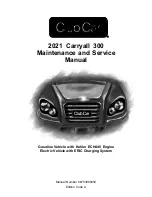
ELECTRICAL SYSTEM AND TESTING
Test Procedures
Page 11-16 1998/1999 PowerDrive Plus Maintenance and Service Supplement
11
Test Procedure 4–Multi-step Potentiometer (Wiper Switch) Voltage, Continued:
6. If reading does not decrease as pedal is depressed, check movable contact and resistors in wiper switch.
7. If the reading is not zero volts with the pedal fully depressed, the vehicle will not operate at rated top speed.
Check the resistors and adjustment of the wiper switch assembly.
7.1.
Disconnect the six-pin connector at multi-step potentiometer.
7.2.
Using a multimeter set to 20K ohms, connect black (-) lead of multimeter to purple wire terminal end
(located in six-pin connector on potentiometer). Connect red (+) lead (with insulation probe) to yellow wire
at six-pin connector.
7.3.
Measure resistance while depressing the accelerator pedal. The measured resistance should increase
incrementally in six steps:
1st Step:
910 ohms (approx.)
2nd Step:
1660 ohms (approx.)
3rd Step:
2570 ohms (approx.)
4th Step:
3570 ohms (approx.)
5th Step:
4570 ohms (approx.)
6th Step:
5570 ohms (approx.)
7.4.
If the resistance steps were not correct and the accelerator pedal is properly adjusted, then replace the
defective resistor(s).
See Section 12–Components
.
7.5.
Reconnect six-pin connector assembly.
8. If reading is zero volts, check continuity of yellow wire and six-pin connector terminal at wiper switch.
Test Procedure 5 - A1 and A2 Motor Voltage
1. Using a multimeter set to 200 volts DC, place the black lead on the A2 motor terminal (white wire) and con-
nect the red lead to the A1 (green wire) motor terminal.
See DANGER on page 11-11.
2. With Tow/Run switch in RUN, place Forward/Reverse switch in FORWARD, turn key switch ON and slowly depress
accelerator pedal.
3. As the accelerator pedal is depressed, the voltage reading should increase from approximately 5 volts when the
accelerator limit switch closes, to approximately 48 volts with the accelerator pedal fully depressed.
3.1.
If there is no voltage reading, check the wiper switch
(see Test Procedure 4)
and the continuity of the large
post of the main solenoid
(see Test Procedure 15)
.
3.2.
Disconnect battery wires. Check continuity on A1 and A2 motor terminal posts and continuity of the F1 and
F2 motor terminal posts. Also, check continuity of all motor wires.
See Section 15–Motor.
Test Procedure 6 - Tow/Run Switch
1. Using a multimeter set on 200 volts DC, connect black lead to negative post of battery No. 6 and connect red lead
(with insulation probe) on black wire on two-pin connector on Tow/Run switch. (Connect the insulation probe to the
black wire on the wire harness side of the two-pin connector).
See WARNING on page 11-11.
2. With the Tow/Run switch in the RUN position, the reading should be approximately 48-50 volts. With the
switch in the TOW position, the reading should be zero volts.
3. If the reading is not zero volts with the switch in the TOW position, replace the switch.
4. If the reading is zero volts with switch in the RUN position, check continuity of the two-pin connector and the red/
white 18 gauge wire from the large post of the solenoid to the two-pin connector at the Tow/Run switch.
•
IF AN INCREASE IN RESISTANCE FROM 0 TO (APPROXIMATELY) 5000 OHMS IS OBTAINED WHEN THE
ACCELERATOR PEDAL IS DEPRESSED WITHOUT EXCEEDING (APPROXIMATELY) 7000 OHMS, THEN THE SPEED
SWITCH RESISTOR ASSEMBLY IS IN GOOD CONDITION.
NOTE
Содержание 1998 DS
Страница 2: ......
Страница 8: ...Page vi 1998 1999 PowerDrive Plus Vehicle Maintenance and Service Supplement...
Страница 56: ...12...
Страница 72: ...13...
Страница 98: ...14...
Страница 128: ...16...
Страница 129: ...Club Car R NOTES...
Страница 130: ...Club Car R NOTES...
Страница 131: ......












































